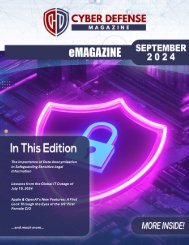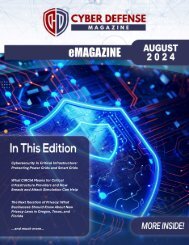Cyber Defense eMagazine May 2019
Cyber Defense eMagazine May Edition for 2019 #CDM #CYBERDEFENSEMAG @CyberDefenseMag by @Miliefsky a world-renowned cybersecurity expert and the Publisher of Cyber Defense Magazine as part of the Cyber Defense Media Group
Cyber Defense eMagazine May Edition for 2019 #CDM #CYBERDEFENSEMAG @CyberDefenseMag by @Miliefsky a world-renowned cybersecurity expert and the Publisher of Cyber Defense Magazine as part of the Cyber Defense Media Group
You also want an ePaper? Increase the reach of your titles
YUMPU automatically turns print PDFs into web optimized ePapers that Google loves.
More than a Buzzword: Survey Reveals <strong>Cyber</strong> Threat<br />
Intelligence Trends<br />
By Corin Imai, Senior Security Advisor, DomainTools<br />
<strong>Cyber</strong> Threat Intelligence (CTI), the collection and analysis of information about current and potential<br />
cyber-attacks and attempts, has evolved significantly in recent years. The accumulation and research of<br />
cyber threat data across human insights, open source information and technical intelligence from<br />
cybersecurity tools, has reached mainstream adoption, according to according a <strong>2019</strong> Ponemon Report:<br />
The Value of Threat Intelligence from Anomali. Now viewed as a critical resource for enterprise security,<br />
CTI is widely relied upon to inform and develop proactive cybersecurity measures.<br />
With new challenges emerging, improvements in CTI best practices have come at an opportune time. An<br />
ever-changing matrix across commoditized malware, nation-state actors, cyber cold warfare activities,<br />
and a broadening landscape of connected devices that need to be secured, is pulling cybersecurity teams<br />
in a myriad of directions. As cybersecurity technology has advanced, practitioners and experts have<br />
deepened their knowledge on how CTI is collected, shared and used. However, practitioners with relevant<br />
and appropriate expertise, leaves organizations lacking the resources needed to effectively stay ahead<br />
of threat actors. The shortage of skilled cybersecurity practitioners around the globe has never had more<br />
of an impact, according to research from (ISC)2 which discovered 63% of participating organizations are<br />
suffering through a shortage of IT staff dedicated to cybersecurity. Moreover, nearly 60% of respondents<br />
said their companies are at “moderate” or “extreme” risk of cybersecurity attacks as a result of the<br />
shortage.<br />
Given these challenges, strategic use of CTI is critically important. Enterprises are beginning to recognize<br />
this and prioritize threat intelligence. The <strong>2019</strong> EMA Megatrends in <strong>Cyber</strong>security report found that threat<br />
intelligence is an important area of focus for security practitioners in the coming year. In the study, when<br />
asked “which of the following broad security initiatives are driving current priorities in your overall security<br />
program?,” respondents ranked improving threat intelligence among the highest in the ‘expanding’<br />
bucket, at 57 percent, with only 8 percent of companies not prioritizing threat intelligence in some way.<br />
To better understand trends around CTI best practices and how they have changed, the SANS Institute<br />
recently conducted its fifth consecutive <strong>Cyber</strong> Threat Intelligence Survey. The <strong>2019</strong> results revealed<br />
insights into CTI as a mechanism for cybersecurity detection, prevention and response, and how its use<br />
has evolved alongside the cybersecurity ecosystem.<br />
Strategic Improvements<br />
The survey results were clear that CTI is on an upward trajectory both in the number of organizations<br />
using it and the extent to which it is applied. Seventy two percent of respondents said they are utilizing<br />
76


















